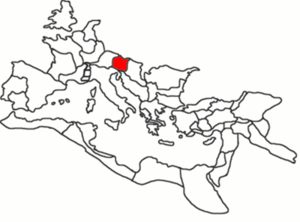Noricum

Noricum, in ancient geography, was a Celtic kingdom (perhaps better described as a federation of, by tradition, twelve tribes) stretching over the area of today's Austria and Slovenia. It became a province of the Roman Empire. It was bounded on the north by the Danube, on the west by Raetia and Vindelicia, on the east by Pannonia, on the south by Italia and Dalmatia. It roughly corresponds to the greater part of modern Styria and Carinthia, and part of Austria west of Vienna, Bavaria and Salzburg. It´s seen as the beginning of Austrian history while there was the concrete idea of Austrias 1st President Dr. Karl Renner to give the country the name "Norische Republik" or "Republic of Noricum" because the ancient Borders as far as known are quite similar to modern Austrias.
Characteristics
The original population appears to have consisted of Pannonians (a people kin to the Illyrians), who after the great emigration of the Gauls became subordinate to various Celto-Ligurians tribes, chief amongst them being the Taurisci, probably called Norici by the Romans from their capital Noreia (Neumarkt in der Steiermark).
The country is mountainous and the soil relatively poor except in the southeastern parts, but it proved rich in iron and supplied material for the manufacturing of arms in Pannonia, Moesia and northern Italy. The famous Noric steel was largely used in the making of Roman weapons ("Noricus ensis," Horace, Odes, i. 16. o).
The inhabitants were a brave and warlike people, who paid more attention to cattle-breeding than to agriculture, although it is probable that the Romans, by draining the marshes and cutting down timber, increased the fertility of the soil. Gold and salt were also found in considerable quantities; the plant called saliunca (the wild or Celtic nard) grew in abundance, and was used as a perfume (Pliny the Elder, Naturalis Historia xxi. 20.43). Noricum was the southern outpost of the northern or Celtic peoples and the starting-point of their attacks upon Italy during the second half of the Iron Age when the celts become powerful over another cultures as illyrians. It is in Noricum that we first hear of almost all these Celtic invaders. Archaeological research, particularly in the cemeteries of Hallstatt, less than 40 km from Noreia, have shown that there was a vigorous civilization there centuries before recorded history, but we need to be careful because the Hallstatt civilization were an cultural manifestation previous to the celtic invasions and are close to the illyrians who were the real inhabitants of this region. The Hallstatt cemeteries contained weapons and ornaments from the Bronze age, through the period of transition, up to the fully-developed Iron age in fact the first half of the Iron Age have as principal manifestation on central Europe to the "Hallstatt culture" with their particular plastic style different from the late celtic style from "La Téne" culture. Ridgeway has made a strong case for the theory that the cradle of the Homeric Achaeans was in Noricum and neighbouring areas.
Language
The Noric language was a Continental Celtic language. It is attested in only two fragmentary inscriptions, which do not provide enough information for any conclusions about the nature of the language to be drawn.
Roman rule

Noricum was incorporated into the Roman Empire in 16 BC. For a long time the Noricans enjoyed independence under princes of their own and carried on commerce with the Romans. In 48 BC they took the side of Julius Caesar (circa 100 BC-44 BC) in the civil war against Pompey (106 BC-48 BC). In 16 BC, having joined with the Pannonians in invading Histria, they were defeated by Publius Silius, proconsul of Illyricum. Thereafter, Noricum was called a province, although it was not organized as such. It remained a kingdom with the title regnum Noricum and was under the control of an imperial procurator. It was not until the reign of Antoninus Pius that the legion II Pia (afterwards called Italica) was stationed at Noricum, and the commander of the legion became the governor of the province. Under the reign of emperor Claudius (41-54) the Noricum Kingdom was ultimately incorporated to the Roman Empire apparently without offering resistance.
Under Diocletian (245-313), Noricum was divided into Noricum ripense ("Noricum along the river," the northern part southward from the Danube) and Noricum mediterraneum ("Noricum nearer the sea", the southern, more mountainous district). Their border with each other ran along the central part of the eastern Alps. Each division was under a praeses, and both belonged to the diocese of Illyria in the Praetorian prefecture of Italy.
The Roman colonies and chief towns were Virunum (Maria Saal near Klagenfurt, medieval Clagenfurtum, Celovec), Flavia Solva (near Leibnitz, Lipnica), Ovilava (Wels), Celeia (Celje), Juvavum (Salzburg), Lauriacum (Lorch), at the mouth of the Enns, the ancient Anisus).
References
- This article incorporates text from a publication now in the public domain: Chisholm, Hugh, ed. (1911). Encyclopædia Britannica (11th ed.). Cambridge University Press.
{{cite encyclopedia}}: Missing or empty|title=(help)
